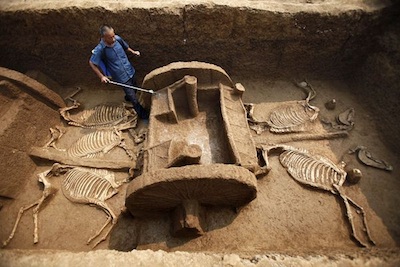 In this week’s ScienceSaturday, reduce, reuse, and recycle an entire rocket; see Mercury as it’s never been seen before; witness the launch of China’s first ever space laboratory; and uncover an entire fleet of 2,500 year old chariots in China. All this and more, plus our gadget of the week: AlphaDog robot!
In this week’s ScienceSaturday, reduce, reuse, and recycle an entire rocket; see Mercury as it’s never been seen before; witness the launch of China’s first ever space laboratory; and uncover an entire fleet of 2,500 year old chariots in China. All this and more, plus our gadget of the week: AlphaDog robot!
SpaceX Unveils Plans for World’s First Fully Reusable Rocket
Private space company SpaceX has unveiled their plans to build the first ever fully reusable rocket, a move that would significantly cut down on launch costs and help pave the way for sending humans to the moon, Mars, and beyond. We’re talking fully reusalbe. The first stage rocket, second stage, and even the manned capsule. SpaceX CEO Elon Musk said in a press conference this Thursday that the “exploration and colonization of other worlds” will be made more feasable with the new rocket design.
New Observations of Mercury Reveal Unprecidented Detail
After only half a year in orbit around Mercury, the NASA MESSENGER spacecraft has sent back data that has completely changed what we know about the innermost planet. New observations, including imagery of one lava flow that would cover much of the continental US, suggests that flood volcanism has been widespread on Mercury in the planet’s past. MESSENGER has also sent back high resolution images of Mercury’s “hollows”, the first direct measurements of the planets chemical makeup, and the first global inventory of Mercury’s plasma ions.
“These revelations emphasize that Mercury is a fascinating world that is unmatched in the solar system,” says David Blewett, a staff scientist working with MESSENGER data. “We have barely begun to understand what Mercury is really like and are eager to discover what Mercury can tell us about the processes that led to formation of the planets as we see them today.”

A 3.5 billion year old lava flow, which would cover nearly 60% of the continental US

A crater floor partially covered in “hollows”
China Launches 1st Module of Chinese Space Station
A rocket carrying the first piece of China’s first space laboratory, Tiangong-1, launched from the Gobi desert this week. Tiangong means “heavenly place” in Chinese. The module is unmanned for now, but astronauts (aka yuhangyuans) should visit within the next year. In a few weeks, China will launch Shenzhou 8, the second link to the space lab. The rendezvous and docking of the two modules is essential for future construction of the lab. China has promised to finish the station by the end of the decade.
Ancient Chariot Fleet, Complete with Horses, Unearthed in China
An extremely well preserved fleet on 2,500 year old chariots complete with horses were discovered in the city of Luoyan in central China. A total of 5 chariots and 12 horse skeletons were found in a tomb pit, which archaeologists believe was dug as part of the funeral rites of a minister or nobleman during the Eastern Zhou dynasty. Horse-drawn chariots were important vehicles of war during this period and were driven by aristocrats and commoners alike.


2,500 year old chariots and horses unearthed in China
Gadget of the Week: AlphaDog is the Robot We Should Be Sending to Explore Mars
You may remember the amazing BigDog robot, which trots around on all fours and is tough to tip over. Well, it’s gotten an upgrade. Now called the AlphaDog, this robot can haul up to 400 lbs for 20 miles! And, it’s motor skills are skill extremely impressive. Not only can this thing walk, trot, and run on all kinds of rough terrain, it can even flip itself back onto its feet if it falls over. Watch both videos below for some amazing demos.
Science Bytes
Not enough science for you? Here’s a warp-speed look at some more science tid-bits that are worth a peek.
- Space telescopes reveal secrets of a turbulent black hole
- Heavy metal stars produce Earth-like planets
- Scientists discover a ‘master key’ to unlock new treatments for autoimmune disorders

AlphaDog robot? Are they going to call it Rags?
(Woody Allen joke)
Trekmovie missed the 100-year starship in development.
http://www.foxnews.com/scitech/2011/10/01/100-year-starship-us-agencies-ponder-interstellar-travel/
Didn’t know how to submit this.
The reusable rocket is impressive, but wont the extra weight of re-entry and landing fuel be a waste?
Whats wrong with old fashioned parachutes?
Horse Skeletons found in tomb??
Now PETA will be filing a Law Suit for Animal Cruelty.
3.
Talk about beating a dead horse!
2… That’s actually old news, first discussed about a year ago. “In development” is seriously overstating things. This is really not much more than a thought experiment anyway, with DARPA trying to get companies to think up world-changing innovations.
SpaceX’s Reusable Falcon is actually the big news here with a potential relatively near-term big payoff. We might be approaching a “perfect storm” of space exploration, with private rockets and spacecraft to lay the foundations and NASA’s big SLS rocket to do the heavy lifting, such as launching a big, expensive Mars expedition ship that would be fueled in orbit and crews brought up by low-cost commercial partners.
I’m hoping we can have a friendly competition with the Chinese space agency as we move forward from the shuttle era. Something like this is exactly what NASA has needed since the end of the Cold War. As bad as the old Soviet Empire was, it did give some excellent motivation in getting our butts in gear and beating them to the Moon.
Thanks, Sputnik!
Oh, and Yuri Gagarin too!
6… That would be catastrophic. The first space race resulted in a “waste anything but time” effort that was far too costly to be sustainable once the goal (man on the moon) was achieved. Another space race will once again see politicians abandoning the methodical establishment of an affordable system in favor of a “giant leap” approach that will certainly be unaffordable in the long run, and canceled immediately after the goal is achieved. Just like Apollo.
The real goal is to become a true spacefaring civilization, not to be the first to plant a flag on Olympus Mons.
I’m hoping Space X succeeds with the reusable ‘Grasshopper’, but I also remember their string of very public failures with the Falcon. The idea is a good one however, and if there are setbacks, I hope it doesn’t derail this project.
We don’t need another ‘space race’; we need permanent, sustainable, low cost means to get to earth orbit and beyond if we’re truly going to keep our footing in the ‘final frontier.’ As a species, it makes good sense for our future survival, too; otherwise one big asteroid comes along and we’re toast…
As for the Chinese station? Good luck with that. Maybe they’ll realize (as we should’ve) that a space station without an immediate goal is a big, expensive albatross. We (and our ISS partners) could’ve been to Mars already….
The reusable rocket is actually such a no brainer… I’m so glad SpaceX is tackling that issue.. So much money is just thrown away, it makes sense to make something that can be recovered.. Thanks for spreading the word Kayla!
#9
And racing to “plant the flag” on the Moon greatly accelerated technological development, giving us most of the little flashy computerized devices we so enjoy (or are addicted to) today.
In order for us to be a spacefaring civilization the world must first be civilized. In the here and now, competition is a much more realistic approach (at least when dealing with the Chinese steamroller).
The SpaceX idea seems to be a good one but there is a significant difference between proposal and the actual creation of a working vehicle. Hopefully SpaceX is up to the task. With the current economic mess and the real need to cut funding wherever we can, private industry may soon be all there is in space.
That said, NASA’s “Space Launch System” also sounds intriguing and I hope they’re successful in their endeavor but that will likely depend on how much money Congress is able, and willing, to give to NASA. NASA probably shouldn’t expect too much money considering the real need to the federal government to stop spending more than they take in. Not to mention over $14 Trillion in debt (US Debt Clock). Like I said, soon the private sector may be all there is in space.
Reference
U.S. National Debt Clock: Real Time. (2011). Retrieved from http://www.usdebtclock.org/
2, FOX has a nice picture of the Enterprise in that article too. Thanks for posting.
Vertical landing is amazing. Hope it works.
12… Not so much. The major catalyst for the computer industry was the ICBM program, which was a larger effort than the space program, by far. Apollo and the Space Program were in fact offshoots of the ICBM/IRBM/SLBM effort of the 1950s. The need to miniaturize nuclear warheads to fit atop rockets of a reasonable size is almost entirely responsible for today’s computer industry. (That Russia couldn’t do this as well is why their rockets were much larger than ours for many years, that gave them a leg up when it came to launching satellites and people.) Apollo did put a very public face on the technology, moving it out of the black world and into the popular lexicon. But Apollo was a customer, not the instigator.
The talk among some of my rocket engineer friends is that Musk hasn’t totally eliminated parachutes from the mix in the reusable rocket, but for some reason has chosen not to include them in the CGI video. The first stage is shown essentially performing a shuttle RTLS abort profile, and it’s highly questionable as to whether it would have enough fuel for a touchdown as shown. The same for the second stage; the viewer might assume that the stage is also touching down back at the launch site, when the smart money will likely be on a trans-Atlantic touchdown or after one orbit. One of my rocket pals thinks Musk has something going on that he’s not telling us about just yet.
17. Rick Sternbach – October 1, 2011
Looks like the video is selling the coolest part of the concept, and not necessarily being literal. I thought maybe it was cheaper to burn fuel to land them closer to the launch site than to fish them out of the ocean and haul them.
And I HOPE Mr. S.R. Hadden has something going on he’s not telling us about. That’s the fun.
SpaceX landing reminds me of Salvage 1 with Andy Griffith.
17… I don’t think the first stage will have nearly enough Delta V to go transatlantic. For a high inclination orbit like to the Space Station, they might be able to do what the Shuttle called ECAL… East Coast Abort Landing, landing somewhere in the Mid-Atlantic or New England states. That wouldn’t help with traditional due east satellite launches though. I also doubt the second stage will be allowed to overfly Florida after one orbit, so I’d wager it will land at Vandenberg AFB like X-37B.
Parachutes are heavy, but there probably isn’t an alternative. Unless SpaceX buys the abandoned ROTON technology (helicopter-like autorotation), which would be very interesting (but not SpaceX’s modus operandi.)
#16
Okay, have it your way. But that tech wasn’t developed from the US and USSR holding hands and singing Kum Ba Yah.
Cooperation, Kif, is for ballroom dancers. ;)
21… I think it is not in our best interest to repeat either the ICBM Race or the Space Race. Both wasted enormous amounts of our wealth. Let’s just set a goal for what we as a nation or group of nations want to do in space, and do it. Let’s not take our eyes off that ball because China announces it is going to the moon in 2025 or whatever.
#22
I wouldn’t call Apollo wasted money.
That would the shuttle and the ISS—boldly going into orbit… where government boondoggles are made to go.
And China’s space station is just [their] first step.
Hope you can speak Mandarin.
23… Don’t get me wrong, I’m all for space exploration. But Apollo was the wrong way to go about it. We won the Moon Race and it helped win the Cold War, but it cost our Treasury far more than necessary in order to make an arbitrary 1970 deadline and “beat the Russians”. Von Braun’s original plan of various size rockets all of the same family (Saturn C-1 to C-5) with multiple uses, Earth Orbit Rendezvous and assembly at a Space Station was on a course to land us on the moon around 1975, and would have left us with an affordable and scalable architecture which could easily adapt to changing political climates. Apollo which skipped all of the infrastructure and went straight to the ultra-expensive one-use Saturn V (built on a “waste anything but time” ) could not adapt when the Moon landing goal was achieved, and was canceled, leaving us with nothing. We had to start all over again with Shuttle, and because NASA had just done the seemingly impossible by going from 15 minutes space experience to Armstrong on the moon in 8 years, they thought they could field a fully reusable, economically efficient all-purpose space launch system on their first try. They were wrong, and we’ve been stuck paying for Shuttle for almost 40 years. Now the Shuttle is finally museum-bound and we’re finally going back to the von Braun concept of a diverse infrastructure using many types of much more affordable rockets, assembling the spacecraft in orbit and then going on to the Moon, Asteroids, or Mars. We’ve wasted the last 50 years trying everything except what Von Braun suggested we do. Now we’re finally realizing he was right all along.
And look at the specs of this Chinese “Space Station”. It is really just a modified version of the Orbital Module from Shenzhou. Tiny even compared to the first Salyuts or the Spacelab flown aboard the Shuttle. By their own admission, their Space Station won’t fly for another ten years or so. Their fourth manned spaceflight is scheduled for the next month or so, eight years after their first. I think we need not start learning Mandarin just yet.
We don’t need to deplete our Treasury even more to “beat the Chinese” when they are moving at a snail’s pace.
Cool concept of the reusable rocket, but I am still hoping for Genesis from Superman Returns.
#20 – For the trans-Atlantic bit, I was referring to the second stage only. I suspect that the finished vehicle, if they’re able to work out just how much fuel each is going to require and what the added parachute mass/volume is going to be, is going to look way different from the one in the CGI. My bet is that they’ll have to add some solid strap-ons like with the Delta family. My rocket pals also guess that for the Dragon capsule to come down in an all-propulsive mode, there’s going to be no room inside for people or much payload. I suggested that Musk and co. have discovered a fuel with an Isp of 2000. :)
Instead of international competition further spurring on the space program, I think more challenges to private enterprise (such as the Ansari X-Prize) might be a more benign, less Cold-War approach to stir public (and private) interest in space.
If private corporations such as Space X and Virgin Galactic blaze a trail and embarrass NASA enough into getting it’s own act together, I think that might be sufficient motivation for them rather than another hostile, international ‘us vs them’ (Russia, China) scenario…
Space Races are great for short term, immediate ‘finish line’ goals; they won’t be enough for long term sustainment of a true ‘here to stay’ space program (private or federal).
I laugh at the folks who are so against competition…as if competition and cooperation are polar opposites.
Competition is the nature of the beast, our entire evolutionary process is based upon competition…getting better at doing something so your genes get passed on. Even in Star Trek, competition is a fuel to creativity, the difference is that in the Star Trek universe, folks have learned to compete with each other, but without necessarily going the malicious route. Our modern society seems to current be pushing the “win at any costs” methodology or the complete “No winners or losers” school, rather than accepting that the reality is in the middle. Yes, there are going to be winners and losers…but you can still be magnanimous in victory and gracious in defeat…and your competition is not necessarily synonymous with your mortal enemy.
Cooperation is merely pooling competitive resources to win the bigger competition, but it is also only possible if the differences are tolerable to both parties, something I’m not sure an emerging China nor a falling US are capable of.
#24
You make some good points, but, going back to my original comment, I believe the idea of “friendly competition”—emphasis on friendly—is the best way to develop the tech that will eventually get us—ALL of us—to Mars and beyond. Something like the X-Prize between countries (and without all the massive weapons and hard feelings that made the Cold War so terrifying) might work.
Of course, to get to Mars we’ll most likely have to put all our resources together, China included, but now our countries are very much in competition, politically, economically, etc., etc., and it’s inevitable that we’re going to butt heads over outer space as well. An emerging superpower and super-nationalistic China is going to make itself known, like it or not.
Like you, I hope for Star Trek’s peaceful Federation… but I’ve got a nagging feeling it’s going to end up like some combination of the Ferengi… and “Starship Troopers.”
I live fairly close to the Texas test site for SpaceX. In fact, I drove past their facility yesterday. There’s a lot of activity going on there and much more in the near future, according to the FAA document. Things are about to get a lot more exciting.
One comment: I hope the crew aboard future Dragon vehicles take along a set of earplugs, because the noise from the retrofire in the Draco thrusters will be pretty loud, I would imagine.
Either way, if they can make this work, NASA is going to have a difficult time selling SLS to the public. Time will tell.